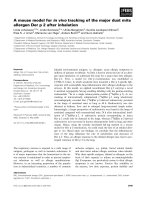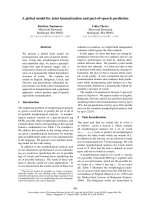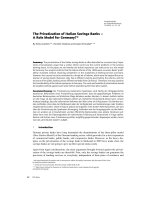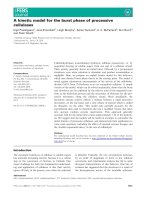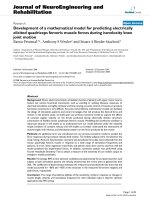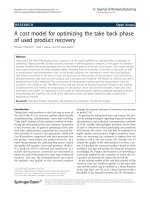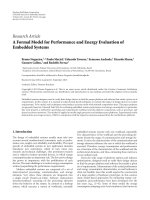A mathematical model for predicting the adult height of girls with advanced puberty after spontaneous growth
Bạn đang xem bản rút gọn của tài liệu. Xem và tải ngay bản đầy đủ của tài liệu tại đây (426.41 KB, 7 trang )
Lemaire et al. BMC Pediatrics 2014, 14:172
/>
RESEARCH ARTICLE
Open Access
A mathematical model for predicting the adult
height of girls with advanced puberty after
spontaneous growth
Pierre Lemaire1,2, Delphine Pierre3, Jean-Baptiste Bertrand4 and Raja Brauner3*
Abstract
Background: Advanced puberty in girls is defined as the onset of puberty between the ages of 8 yr and 10 yr.
The objective was to predict adult height (AH) at initial evaluation and to characterize patients with an actual AH
below −2 SD (152 cm) and/or lower than their target height (TH) by > one SD (5.6 cm).
Methods: Data analysis using multiple linear regression models was performed in 50 girls with advanced puberty
who reached their AH after spontaneous puberty.
Results: The actual AH (159.0 ± 6.1 cm) was similar to the TH (161.2 ± 4.6 cm) and to the AH predicted at the
initial evaluation (160.8 ± 6.0 cm), and the actual AH correlated positively with both (R = 0.76, P = 0.0003; R = 0.71,
P = 0.008, respectively).
The AH was below 152 cm in 7 girls, of whom 3 were characterized by paternal transmission of the advanced
puberty. The AH was lower than the TH by >5.6 cm in 8 girls.
The AH (cm) could be calculated at the initial evaluation: 1.8822 age + 3.3510 height (SD) - 0.7465 bone age – 1.7993
pubic hair stage + 2.8409 TH (SD) + 150.32.
The formula is available online at />The calculated AH (159.0 ± 5.7 cm) and the actual AH were highly correlated (R = 0.93). The actual AH was lower than
the calculated AH by > 0.5 SD in only one case (4.35 cm).
Conclusion: We established a formula that can be used at an initial evaluation to predict the AH, and then to assess
the risk of reduced AH as a result of advanced puberty. According to this formula, the actual AH was lower than the
calculated AH by more than 2.8 cm (0.5 SD) in only one girl. The AHs of the untreated girls with advanced puberty did
not differ from those predicted at the initial evaluation by the Bayley and Pinneau table or from the THs. However, this
study provides a useful and ready-to-use formula that can be an additional assessment of girls with advanced puberty.
Background
Advanced puberty in girls is defined as the onset of puberty
between the ages of 8 and 10 yr. In nearly all cases, advanced puberty, which is a variant of normal puberty, is due
to a familial condition rather than a pathological condition.
The premature secretion of estradiol increases the
growth rate and accelerates bone maturation, which can
shorten the growing period, and it may cause reduced
adult height (AH). Treatment with gonadotropin-releasing
hormone (GnRH) analog blocks the pituitary-ovarian axis,
* Correspondence:
3
Université Paris Descartes and Fondation Ophtalmologique Adolphe de
Rothschild, 75940 Paris, France
Full list of author information is available at the end of the article
thereby preventing the secretion of estradiol, slowing the
bone age (BA) progression and preserving growth potential. This action has been demonstrated in the evolving
forms of idiopathic central precocious puberty in girls [1].
However, in two randomized studies on girls with onset of
puberty at 7.5-8.5 yr [2] and at 8.4-10 yr [3], the AHs were
similar between the untreated patients and the patients
treated with GnRH analog. In a previous study on girls
with advanced puberty [4], we demonstrated that the AHs
of untreated patients and patients treated with GnRH analog were similar between the two groups. Furthermore,
the participants’ AHs were similar to their target heights
(TH) and were significantly below their heights at age 4 yr,
as expressed by the standard deviation score (SDS). The
© 2014 Lemaire et al.; licensee BioMed Central Ltd. This is an Open Access article distributed under the terms of the Creative
Commons Attribution License ( which permits unrestricted use, distribution, and
reproduction in any medium, provided the original work is properly credited. The Creative Commons Public Domain
Dedication waiver ( applies to the data made available in this article,
unless otherwise stated.
Lemaire et al. BMC Pediatrics 2014, 14:172
/>
AH was below the TH by more than 5 cm in 7/40 (17.5%)
girls, 5 of whom were untreated and 2 of whom were
treated. Determining the risk of reduced AH as a result of
advanced puberty is of crucial importance because the age
limit that is used to define central precocious puberty has
decreased over time [5,6].
In the present paper, we studied 50 girls with idiopathic
advanced puberty who reached their AH after undergoing
spontaneous puberty. Data analysis was performed using
multiple linear regression models. The objective was to
predict the AH at the initial evaluation and to characterize
the patients with an actual AH that was below −2 SD and/
or lower than their TH by more than 1 SD.
Methods
Patients
This retrospective, single-center, cohort study was conducted on 50 girls who were monitored for idiopathic
advanced puberty by a senior pediatric endocrinologist
(R. Brauner) in a university pediatric hospital between
1996 and 2006 (all seen after our previous report) [4]
and are currently over the age of 15 yr. The participants
all reached their AH (growth during the preceding year
of less than 1 cm in a menstruating girl) after spontaneous, untreated puberty. Advanced puberty was diagnosed
according to the appearance of breast development between the ages of 8 yr and 10 yr, accompanied by the presence of pubic or axillary hair and/or a growth rate greater
than 2 SDS during the year before a clinical evaluation
(health record data).
The patients were identified by checking computerized
hospital charts for the term “advanced puberty”. Among
the 242 girls followed over the 10 years of the study, 90
girls were excluded for the following reasons: they had
been examined only once (n = 16); they had been
adopted (n = 6); they had a previously diagnosed intracranial abnormality (n = 4, hydrocephalus, Rathke cyst
or hamartoma); they had an associated bone disease or
intrauterine growth retardation or another disease responsible for short stature (n = 12); or they were treated
with GnRH analog because of evolving puberty or advanced puberty that was not psychologically tolerated (n =
52). Until an acceptable predicted AH was reached, the
patients were monitored every 6 months for clinical and
BA evaluations if indicated, and they were subsequently
followed by their physician each year until the AH was
achieved. When the AH was not available in the hospital
record, a letter was sent to the parents asking for the patient’s age and most recent height as indicated in their
health records as well as the patient’s growth in the last
year; these data were collected by the patients’ physicians.
Some of these letters were returned to us because of a
change of address (n = 29), and some parents did not respond (n = 73). At the initial evaluation, the characteristics
Page 2 of 7
of these 102 girls without the AH available and those of
the 50 girls who were included in the study were similar
except for the age at first menstruation, which was lower
in the patients without a response (10.5 ± 0.54 yr) than in
those included in the study (11.2 ± 1.6 yr, P < 0.005).
Methods
The initial evaluation included the following data: age at
the onset of breast development (reported), height chart,
growth rate, weight, pubertal stage, BA, and the height of
each parent (reported), as well as the age of the mother at
her first menstruation. The following heights were collected and expressed as cm and SDS for chronological
age: height at age 4 yr, height at the time of breast development, height at the initial evaluation, height at the first
menstruation and AH. Magnetic resonance imaging was
performed in 5 girls because of the absence of a family history of advanced puberty (mainly a mother who underwent menarche before the age of 11 yr), rapid pubertal
development and/or symptoms such as headache. The imaging was normal in all of the subjects.
Height and body mass index (BMI, weight in kg/height
in m squared) were expressed as SDS for chronological
age [7,8]. For the AH, one SD corresponded to 5.6 cm [7].
The pubertal stage was calculated according to Marshall
and Tanner [9]. The BA was assessed by R. Brauner according to the Greulich and Pyle method [10] in all of the
participants. The TH was calculated based on the parental
heights [11]. The predicted AH was calculated at the initial evaluation [12]; we used the column “advanced” when
the BA advance was greater than one year.
To evaluate the difference induced by advanced puberty, the actual AH was compared to the TH, to the
height at age 4 yr (SD) and to the AH predicted at the
initial evaluation. Pubertal growth was calculated as the
difference in cm between the height at the onset of
breast development and the AH [13], and the duration
of puberty was calculated as the time between this onset
and the first menstruation.
Data analysis was performed using multiple linear regression models. An extensive analysis among the sets of
variables (listed in Methods and Table 1) was conducted,
and the models were validated based on the correlation
of their predictions with the actual values. The robustness of the model was tested using cross-validation: the
model was computed on a random, uniform sample of
80% of the patients and tested on the remaining 20%;
this procedure was performed one hundred times on independently drawn samples.
Results
Characteristics of the population
The age at the onset of puberty was 8.9 ± 0.6 yr and 9.8 ±
0.9 yr at the initial evaluation, with the BA at 10.6 ± 1.4 yr
Lemaire et al. BMC Pediatrics 2014, 14:172
/>
Page 3 of 7
Table 1 Characteristics of 50 girls with advanced puberty and spontaneous growth
n
Mean ± SD
Min
Max
50
8.9 ± 0.6
8
10
Age, yr
50
9.8 ± 0.9
8.25
13.3
Bone age, yr
50
10.6 ± 1.4
8
16
Tanner stage of breast development
50
3.0 ± 1.0
1
5
Age of onset of puberty, yr
Initial evaluation
Tanner stage of pubic hair development
50
2.7 ± 1.1
1
5
BMI, SD
49
0.8 ± 1.2
−1.78
3.92
Duration of puberty, yr
50
2.4 ± 0.9
0.7
4.0
Age at 1st menstruation, yr
50
11.2 ± 0.8
9.8
13.0
Evolution
Growth evolution
Height at onset of puberty, cm
48
132.7 ± 5.7
122.0
145.0
Height at initial evaluation, cm
50
140.30 ± 6.00
128.6
159.0
Height at 1st menstruation, cm
48
149.2 ± 5.6
137.0
162.0
Adult height, cm
50
159.0 ± 6.1
148.0
173.0
Target height, cm
50
161.2 ± 4.6
150.5
171.0
Predicted adult height, cm
50
160.8 ± 6.0
147.5
174.8
Adult – target heights, cm
50
−2.2 ± 4.0
−16.5
7.0
Adult height - height at 1st menstruation, cm
48
9.6 ± 3.6
2.5
17.0
Pubertal growth, cm
48
26.0 ± 4.7
15.0
39.0
(Table 1). The BMI was 0.8 ± 1.2 SDS. The duration of puberty was 2.4 ± 0.9 yr. The age at first menstruation in the
girls was 11.2 ± 0.8 yr; this age was significantly younger
than the corresponding age of their mothers at their first
menstruation, which was 12.5 ± 1.6 yr (P < 0.00001). Nine
mothers (18%) had undergone menarche before the age of
11 yr.
Growth evolution and AH
The AH was similar to the TH and to the AH predicted
at the initial evaluation (Table 1 and Figure 1). The AH
correlated significantly and positively with both the TH
and the predicted AH.
Expressed as SDS, the AH was significantly lower than
the height at age 4 yr (−0.77 ± 1.10 vs 0.52 ± 1.24 SDS), with
a mean height loss of 1.32 SD. Pubertal growth correlated negatively with the age at the onset of puberty
(R = −0.45, P < 0.01) and with the stages of breast development (R = −0.47, P < 0.01) and pubic hair development (R = −0.52, P < 0.001) at the initial evaluation.
The AH was below −2 SD (152 cm) in 7 (14%) girls
(Figure 1). For 3 girls, the father’s height was short
(160 cm, 162 cm and 163 cm), and he had exhibited advanced puberty. Two girls were obese (BMI 2.22 and 2.53
SDS at the first evaluation). Pubertal growth was <20 cm
in 4 of 7 girls. Diseases such as excessive androgen levels,
hypothalamic-pituitary lesions (MRI normal, n = 3) and
congenital bone disease (skeletal radiographies and genetic
advice, n = 3) were excluded.
The AH was lower than the TH by more than one SD
(5.6 cm) in 8 girls, including 4 of 7 girls with heights
below −2 SD. Among the other 4 girls, one had severe
scoliosis, and 3 were obese. Furthermore, among these
girls, the AH SD was similar to the father’s height SD in
2 girls and similar to the mother’s height in 2 girls.
All 11 patients with an AH that was below −2 SD and/
or lower than their TH by more than one SD had begun
to menstruate after age 10.
Prediction of the AH
The AH could be calculated at the initial evaluation,
which was performed 1.0 ± 0.8 yr after the onset of puberty, using the following formula:
AH calculated (SD) = 0.3361 age + 0.5984 height (SD) 0.1333 BA - 0.3213 pubic hair stage + 0.5073 TH (SD) – 2.3187
or using cm for AH as follows:
AH calculated (cm) = 1.8822 age + 3.3510 height (SD) 0.7465 BA – 1.7993 pubic hair stage + 2.8409 TH (SD) +
150.32.
These formulae are available online at http://www.
kamick.org/lemaire/med/girls-advpub.html.
The data required are the age (yr) and height at the
initial evaluation (cm or SD), the BA (yr), the Tanner
Lemaire et al. BMC Pediatrics 2014, 14:172
/>
Page 4 of 7
case (4.35 cm). The quality of the above formula was
confirmed by cross-validation (R = 0.90 on average).
Discussion
We established a formula that can be used at an initial
evaluation to predict the AH and then to assess the risk
of reduced AH as a result of advanced puberty. According to this formula, the actual AH was lower than the
calculated AH by more than 2.8 cm (0.5 SD) in only one
girl, with a difference of 4.35 cm.
Formula for prediction
Figure 1 Correlation between adult height and target height
(a)/predicted adult height at the initial evaluation (b) in 50 girls
with advanced puberty after spontaneous growth. Open circles
indicate those girls with an adult height lower than the target
height by >5.6 cm (one SD). Dotted lines represent −2 SD (152 cm).
stage of pubic hair development, and the heights of the
father and mother (cm or SD).
The calculated AH (159.0 ± 5.7 cm) and the actual
AH were highly correlated (R = 0.93, Figure 2). The actual AH was different from the AH calculated by the formula by more than 5.6 cm (1 SD) in only one case, in
whom the actual AH was greater, and by more than
2.8 cm (0.5 SD) in 11 cases (22%): the actual AH was
greater than the calculated AH in 6 cases, just at the
limit in 4 cases and lower by more than 2.8 cm in one
The formula that can be used at the initial evaluation to
predict the AH includes the TH and data obtained during this evaluation (chronological and bone ages, height
(SD) and pubic hair development stage). In two previous
studies, we used mathematical models to improve the
diagnosis of growth hormone deficiency (GHD) [14] or
to predict the AH in girls with idiopathic central precocious puberty [15]. Using logical analysis data [14], we
have shown that the screening of GHD can be achieved
by employing a simple graph based on insulin-like
growth factor (IGF) 1 and the growth rate: (1) all patients below a given line (growth rate ≤ −7.3 – 1.3 × IGF
(SDS)) had GHD and pituitary stalk interruption syndrome; (2) all but two patients above another given line
(growth rate > −4.5 + 6.4/(IGF + 4.5) (SDS)) did not
have GHD; and (3) in-between, patients in a “gray area”
could not be diagnosed using only the growth rate and
IGF I. The only two out of 54 patients with GHD who
had been misdiagnosed had an abnormal BMI. Using
multiple linear regression [15], we showed that in girls
with untreated idiopathic central precocious puberty, the
difference between the AH and TH (1.7 ± 4.3 cm) can
be predicted at an initial evaluation as follows: 2.76
(height at initial evaluation - TH) - 3.68 LH/FSH peaks
ratio - 3.49; R = 0.88. These formulae are available at
The
actual AH of 9 girls (17%) was >3 cm lower than the AH
predicted by the formula. Four (44%) of the 9 girls had a
BMI >2 SDS, whereas 6 girls (66%) had a BA advance
greater than 2 years at the initial evaluation; the corresponding percentages were 30.8% and 26.9% for the entire group. In the present study on older girls with
advanced, and not precocious, untreated puberty, only
one girl had an actual AH that was more than 3 cm
(4.35 cm) lower than the calculated AH. The formula includes the TH and chronological and bone ages, height
(SD) and pubic hair stage. The GnRH test result is not
included in the formula because this test has not been
performed in girls with advanced puberty. The lower
number of patients with a significant difference between
the calculated and actual AHs is likely due to the proximity to the end of growth. In our three studies on
Lemaire et al. BMC Pediatrics 2014, 14:172
/>
Page 5 of 7
Figure 2 Correlation between actual adult height and calculated adult height in 50 girls with advanced puberty after spontaneous
growth using the formula Plain line represents the reference perfect prediction
(calculated = actual), and dotted lines represent ±0.5 SD from that value.
patients who were followed by R. Brauner (GHD, central
precocious puberty and advanced puberty), most misclassifications were associated with an abnormal BMI.
These misclassifications likely occurred because increased BMI is associated with earlier pubertal development [16,17], namely, earlier pubic hair development
[18], an increased growth rate and BA progression [19].
Does advanced puberty decrease the growth potential?
In the present study, the AH was not different from the
TH or from the AH predicted at the initial evaluation,
and the AH correlated significantly and positively with
both the TH and the predicted AH. This observation has
been reported in previous studies on untreated girls with
central precocious puberty [20] and advanced puberty
[2,3,21]. Additionally, these studies have shown that the
AH is not different between untreated girls and girls
treated with GnRH analog.
The AH was below −2 SD (152 cm) in 14% of the girls.
What are the factors that contributed to this short height,
and can we predict them? What are the roles of obesity
and the increase of insulin in the progression of bone maturation? What is the role of the transmission of advanced
puberty by the paternal family, and not the maternal family, as typically observed in precocious puberty [22]?
Bar et al. [20] reported that only 10% of untreated girls
with idiopathic precocious puberty had an AH < 150 cm
(1st percentile, −2.3 SD), whereas 90% of untreated girls
achieved a normal height, which is slightly less than the
average for healthy American girls (163.8 cm). These authors also observed that 75% of the group achieved a
height within 6.3 cm of the initial predicted AH. Lazar
et al. [21] reported that 67% of untreated girls with
advanced puberty achieved or surpassed the TH range
(TH ± 0.5 SD). In the present study, the corresponding
percentage was 52%.
We aimed to compare the AH to the height at age
4 yr (SD) for two reasons. First, the differences in height
that are due to genetic factors occur before this age, between birth and approximately 2.5 to 3 yr of age. Second, the height at the initial evaluation, expressed as the
SD, is influenced by sex steroid secretion, which does
not affect the growth rate at age 4 yr. We therefore
found that the height (SD) at the initial evaluation was
significantly greater than that at age 4 yr.
What are the mechanisms that compensate for the
decrease in growth potential?
In the present study, the increases in the duration of puberty and pubertal growth were sufficient to compensate
Lemaire et al. BMC Pediatrics 2014, 14:172
/>
Page 6 of 7
for the decrease in height induced by the premature secretion of estradiol, which accelerates the progression of
BA.
Thus, the duration of puberty was greater than the
normal duration (2 yr) in the present study (2.4 yr) and
in previously reported studies (4.9 yr [20], 2.45 yr [21]),
3.2 yr [23]). In our earlier study on the prediction of AH
in girls with central precocious puberty [15], the duration of puberty could be predicted using a formula
available at />html. The duration of puberty was longer in girls who
were youngest at the onset of puberty and in those who
had a smaller difference between the height at the initial
evaluation and the TH. Marti-Henneberg et al. [24]
showed a negative correlation between the age at the
onset of puberty and the duration of puberty and between the age at the onset of puberty and the age at first
menstruation. Rosenfield et al. [25] reported slightly
early menarche (0.5 yr) despite thelarche that occurred
1.3 yr early.
The height gain between the onset of puberty and the
achievement of the AH (26.0 ± 4.7 cm) was greater than
that reported by Tanner et al. [13] during normal puberty (25 cm). In the present study, the girls had gained
more height between the first menstruation and the
achievement of the AH (9.6 cm) than girls who had first
menstruated at the age of 13 yr (7 cm) [26].
girls with advanced puberty. We advise that additional
investigations be conducted to validate our predictions
in studies at other institutions.
Study limitations
Received: 22 February 2014 Accepted: 25 June 2014
Published: 3 July 2014
This study has several limitations. It is retrospective and
limited to 50 girls. The girls who were excluded because
of the change in their address may introduce bias. We
postulate that the similarity of these girls to the girls
who were included with regard to the variables analyzed
limits this bias. The AHs of only a few of the girls were
collected from health records held by their pediatricians,
and the height reported by parents is less accurate than
the measured height. The major limitation is the lack of
validation of the formula on a separate patient population. However, this study provides a useful and ready-touse formula for AH prediction.
Conclusion
Advanced puberty is a variant of normal puberty and
does not typically require medical care. Its occurrence in
children with short stature may accentuate the deficit.
We established a formula that can be used at an initial
evaluation to predict the AH and then to assess the risk
of reduced AH as a result of advanced puberty. The
AHs of the untreated girls with advanced puberty did
not differ from those predicted at the initial evaluation
by the Bayley and Pinneau table or from the THs. However, this study provides a useful and ready-to-use formula that can be used as an additional assessment for
Statement of the ethical review committee
The Ethical Review Committee (Comité de Protection
des Personnes, Ile de France III) approved this retrospective study and stated that “This study appears to be in accordance with the scientific principles generally accepted
and to the ethical standards of research. The study was
lead in the respect of the French law and regulation”.
Abbreviations
AH: Adult height; BA: Bone age; BMI: Body mass index; GHD: Growth
hormone deficiency; GnRH: Gonadotropin-releasing hormone; IGF: Insulin-like
growth factor; SDS: Standard deviation score; TH: Target height.
Competing interests
The authors declare that they have no competing interests.
Authors' contributions
PL analyzed the data, prepared the Table and Figures and participated in the
preparation of the manuscript. DP and J-BB participated in the conception
and design and the acquisition of data. RB directed the work and prepared
the manuscript. All authors read and approved the final manuscript.
Author details
1
Université Grenoble Alpes, G-SCOP, F-38000 Grenoble, France. 2CNRS,
G-SCOP, F-38000 Grenoble, France. 3Université Paris Descartes and Fondation
Ophtalmologique Adolphe de Rothschild, 75940 Paris, France. 4Service de
pédiatrie et néonatologie, Centre hospitalier de Courbevoie-Neuilly-Puteaux,
92205 Neuilly sur Seine, France.
References
1. Brauner R, Adan L, Malandry F, Zantleifer D: Adult height in girls with
idiopathic true precocious puberty. J Clin Endocrinol Metab 1994,
79:415–420.
2. Cassio A, Cacciari E, Balsamo A, Bal M, Tassinari D: Randomised trial of
LHRH analogue treatment on final height in girls with onset of puberty
aged 7.5-8.5 years. Arch Dis Child 1999, 81:329–332.
3. Bouvattier C, Coste J, Rodrigue D, Teinturier C, Carel JC, Chaussain JL,
Bougnères PF: Lack of effect of GnRH agonists on final height in girls
with advanced puberty: a randomized long-term pilot study.
J Clin Endocrinol Metab 1999, 84:3575–3578.
4. Couto-Silva AC, Adan L, Trivin C, Brauner R: Adult height in advanced
puberty with or without gonadotrophin hormone releasing hormone
analog treatment. J Pediatr Endocrinol Metab 2002, 15:297–305.
5. Kaplowitz PB, Oberfield SE: Reexamination of the age limit for defining
when puberty is precocious in girls in the United States: implications for
evaluation and treatment. Drug and Therapeutics and Executive
Committees of the Lawson Wilkins Pediatric Endocrine Society.
Pediatrics 1999, 104:936–941.
6. Aksglaede L, Sørensen K, Petersen JH, Skakkebaek NE, Juul A: Recent
decline in age at breast development: the Copenhagen Puberty Study.
Pediatrics 2009, 123:e932–e939. doi:10.1542/peds.2008-2491.
7. Sempe M, Pedron G, Roy-Pernot MP: Auxologie, Méthode et Séquences. Paris:
Théraplix; 1979.
8. Rolland-Cachera MF, Cole TJ, Sempé M, Tichet J, Rossignol C, Charraud A:
Body Mass Index variations: centiles from birth to 87 years. Eur J Clin Nutr
1991, 45:13–21.
9. Marshall WA, Tanner JM: Variations in the pattern of pubertal changes in
girls. Arch Dis Child 1969, 44:291–303.
10. Greulich WW, Pyle SI: Radiographic Atlas of Skeletal Development of the Hand
and Wrist. 2nd edition. Stanford, California: Stanford University Press; 1959.
Lemaire et al. BMC Pediatrics 2014, 14:172
/>
Page 7 of 7
11. Tanner JM, Goldstein H, Whitehouse RH: Standards for children’s height
at ages 2–9 years allowing for height of parents. Arch Dis Child 1970,
47:755–762.
12. Bayley N, Pinneau SR: Tables for predicting adult height from skeletal
age: revised for use with Greulich Pyle hand standards. J Pediatr 1952,
50:432–441.
13. Tanner JM, Whitehouse RH, Marubini E, Resele LF: The adolescent growth
spurt of boys and girls of the Harpenden growth study. Annals Hum Biol
1976, 3:109–126.
14. Lemaire P, Brauner N, Hammer P, Trivin C, Souberbielle J-C, Brauner R:
Improved screening for growth hormone deficiency using logical
analysis data. Med Sci Monit 2009, 15:MT5–MT10.
15. Allali S, Lemaire P, Couto-Silva A-C, Prété G, Trivin C, Brauner R: Predicting
the adult height of girls with central precocious puberty. Med Sci Monit
2011, 17:H41–H48.
16. Davison KK, Susman EJ, Birch LL: Percent body fat at age 5 predicts earlier
pubertal development among girls at age 9. Pediatrics 2003, 111:815–821.
17. Biro FM, McMabon RP, Striegel-Moore R, Crawford PB, Obarzanek E,
Morrison JA, Barton BA, Falkner F: Impact of timing of pubertal maturation
on growth in black and white female adolescents: The National Heart,
Lung, and Blood Institute Growth and Health Study. J Pediatr 2001,
138:636–643.
18. Giabicani E, Allali S, Durand A, Sommet J, Couto-Silva A-C, Brauner R:
Presentation of 493 consecutive girls with idiopathic central precocious
puberty: a single-center study. PLoS ONE 2013, 8(7):e70931.
doi:10.1371/journal.pone.0070931.
19. Charkaluk M-L, Trivin C, Brauner R: Premature pubarche as an indicator of
how body weight influences the onset of adrenarche. Eur J Pediatr 2004,
163:89–93.
20. Bar A, Linder B, Sobel EH, Saenger P, DiMartino-Nardi J: Bayley-Pinneau
method of height prediction in girls with central precocious pubery:
correlation with adult height. J Pediatr 1995, 126:955–958.
21. Lazar L, Kauli R, Pertzelan A, Philip M: Gonadotropin-suppressive therapy
in girls with early and fast puberty affects the pace of puberty but not
total pubertal growth or final height. J Clin Endocrinol Metab 2002,
87:2090–2094.
22. De Vries L, Kauschansky A, Shohat M, Phillip M: Familial central precocious
puberty suggests autosomal dominant inheritance. J Clin Endocrinol
Metab 2004, 89:1794–1800.
23. Llop-Vinolãs D, Vizmanos B, Closa Monasterolo R, Escribano Subias J,
Fernàndes-Ballart JD, Marti-Henneberg C: Onset of puberty at eight years
of age in girls determines a specific tempo of puberty but does not
affect adult height. Acta Paediatr 2004, 93:874–879.
24. Marti-Henneberg C, Vizmanos B: The duration of puberty in girls is related
to the timing of its onset. J Pediatr 1997, 131:618–621.
25. Rosenfield RL, Lipton RB, Drum ML: Thelarche, pubarche and menarche
attainment in children with normal and elevated body mass index.
Pediatrics 2009, 123:84–88.
26. Roy M-P, Sempe M, Orssaud E, Pedron G: Evolution Clinique de la puberté
de la fille. Arch Franç Pediatr 1972, 29:155–168.
doi:10.1186/1471-2431-14-172
Cite this article as: Lemaire et al.: A mathematical model for predicting
the adult height of girls with advanced puberty after spontaneous growth.
BMC Pediatrics 2014 14:172.
Submit your next manuscript to BioMed Central
and take full advantage of:
• Convenient online submission
• Thorough peer review
• No space constraints or color figure charges
• Immediate publication on acceptance
• Inclusion in PubMed, CAS, Scopus and Google Scholar
• Research which is freely available for redistribution
Submit your manuscript at
www.biomedcentral.com/submit
